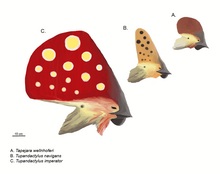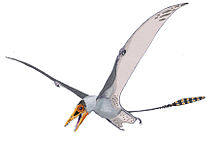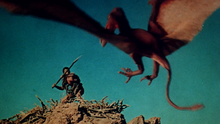Pterosaur
Pterosaurs spanned a wide range of adult sizes, from the very small anurognathids to the largest known flying creatures, including Quetzalcoatlus and Hatzegopteryx,[12][13][14] which reached wingspans of at least nine metres.Pterodactyloids include the clades Ornithocheiroidea (Istiodactylus, Ornithocheirus, Pteranodon), Ctenochasmatoidea (Ctenochasma, Pterodactylus), Dsungaripteroidea (Germanodactylus, Dsungaripterus), and Azhdarchoidea (Tapejara, Tupuxuara, Quetzalcoatlus).Small flyers with shortened jaws and a wide gape, some had large eyes suggesting nocturnal or crepuscular habits, mouth bristles, and feet adapted for clinging.Evidence of webbing between the three free fingers of the pterosaur forelimb suggests that this forward membrane may have been more extensive than the simple pteroid-to-shoulder connection traditionally depicted in life restorations.[60] This view was contradicted in a 2007 paper by Chris Bennett, who showed that the pteroid did not articulate as previously thought and could not have pointed forward, but rather was directed inward toward the body as traditionally interpreted.This indicates the presence of a unique form of melanosomes within pterosaur integument at the time, distinct from previously known contemporary integumentary structures and more similar to those reported from mammalian hair and avian feathers.[92] Scientific opinion at the time was that if such creatures were still alive, only the sea was a credible habitat; Collini suggested it might be a swimming animal that used its long front limbs as paddles.[93] A few scientists continued to support the aquatic interpretation even until 1830, when German zoologist Johann Georg Wagler suggested that Pterodactylus used its wings as flippers and was affiliated with Ichthyosauria and Plesiosauria.[103] Later in the century, the Early Cretaceous Cambridge Greensand produced thousands of pterosaur fossils, that however, were of poor quality, consisting mostly of strongly eroded fragments.[110] This material gave birth to a German school of pterosaur research, which saw flying reptiles as the warm-blooded, furry and active Mesozoic counterparts of modern bats and birds.They saw them as failed evolutionary experiments, cold-blooded and scaly, that hardly could fly, the larger species only able to glide, being forced to climb trees or throw themselves from cliffs to achieve a take-off.In 1914, for the first-time pterosaur aerodynamics were quantitatively analysed, by Ernest Hanbury Hankin and David Meredith Seares Watson, but they interpreted Pteranodon as a pure glider.From the 1960s onwards, a dinosaur renaissance took place, a quick increase in the number of studies and critical ideas, influenced by the discovery of additional fossils of Deinonychus, whose spectacular traits refuted what had become entrenched orthodoxy.[121] During the 1970s, the Early Cretaceous Santana Formation in Brazil began to produce chalk nodules that, though often limited in size and the completeness of the fossils they contained, perfectly preserved three-dimensional pterosaur skeletal parts.Even more productive was the Early Cretaceous Chinese Jehol Biota of Liaoning that since the 1990s has brought forth hundreds of exquisitely preserved two-dimensional fossils, often showing soft tissue remains.[25] Basal archosauromorps such as these seemed to be good candidates for close pterosaur relatives due to their long-limbed anatomy; especially notable is Sharovipteryx, which posessed skin membranes on its hindlimbs likely used for gliding.They concluded that, although more basal pterosauromorphs are needed to clarify their relationships, current evidence indicates that pterosaurs are avemetatarsalians, as either the sister group of Scleromochlus or a branch between the latter and Lagosuchus.[132] A 2011 archosaur-focused phylogenetic analysis by Sterling Nesbitt benefited from far more data and found strong support for pterosaurs being avemetatarsalians, though Scleromochlus was not included due to its poor preservation.[clarification needed] Rupert Wild in 1983 proposed a hypothetical "propterosaurus": a lizard-like arboreal animal developing a membrane between its limbs, first to safely parachute and then, gradually elongating the fourth finger, to glide.[151] This "apomorophy-based" definition was adopted by the PhyloCode in 2020 as "[T]he clade characterized by the apomorphy fourth manual digit hypertrophied to support a wing membrane, as inherited by Pterodactylus (originally Ornithocephalus) antiquus (Sömmerring 1812)".[1][146] Eopterosauria Dimorphodontia Campylognathoididae Rhamphorhynchidae Sordes Darwinoptera Changchengopterus Anurognathidae Kryptodrakon Germanodactylidae Pterodactylus Ctenochasmatoidea Haopterus Tapejaromorpha Neoazhdarchia Piksi Pteranodontia Ornithocheiromorpha The mechanics of pterosaur flight are not completely understood or modeled at this time.In this case, it was unclear how the larger ones of enormous size, with an inefficient cold-blooded metabolism, could manage a bird-like takeoff strategy, using only the hind limbs to generate thrust for getting airborne.In the 1980s, paleontologist Kevin Padian suggested that smaller pterosaurs with longer hindlimbs, such as Dimorphodon, might have walked or even run bipedally, in addition to flying, like road runners.[171] Pteranodontians conversely have several speciations in their humeri interpreted to have been suggestive of a water-based version of the typical quadrupedal launch, and several like boreopterids must have foraged while swimming, as they seem incapable of frigatebird-like aerial hawking.Dimorphodon, envisioned as a puffin analogue in the past, is indicated by its jaw structure, gait, and poor flight capabilities, as a terrestrial/semiarboreal predator of small mammals, squamates, and large insects.In the 1 July 2004 edition of Nature, paleontologist Éric Buffetaut discusses an Early Cretaceous fossil of three cervical vertebrae of a pterosaur with the broken tooth of a spinosaur, most likely Irritator, embedded in it.[195] This was supported by the description of an additional pterosaur egg belonging to the genus Darwinopterus, described in 2011, which also had a leathery shell and, also like modern reptiles but unlike birds, was fairly small compared to the size of the mother.[202] For the majority of pterosaur species, it is not known whether they practiced any form of parental care, but their ability to fly as soon as they emerged from the egg and the numerous flaplings found in environments far from nests and alongside adults has led most researchers, including Christopher Bennett and David Unwin, to conclude that the young were dependent on their parents for a relatively short period of time, during a period of rapid growth while the wings grew long enough to fly, and then left the nest to fend for themselves, possibly within days of hatching.In the latter, animator Ray Harryhausen had to add inaccurate bat-like wing fingers to his stop motion models in order to keep the membranes from falling apart, though this particular error was common in art even before the film was made.Errors persisting were teeth while toothless Pteranodon was intended to be depicted, nesting behavior that was known to be inaccurate by 2001, and leathery wings, rather than the taut membranes of muscle fiber required for pterosaur flight.










( bp : brachiopatagium, cp : cruropatagium, pp : propatagium)






























NovialoideaPterodactylusPterodactyl (disambiguation)Late TriassicLate CretaceousPreꞒDimorphodonAnurognathusQuetzalcoatlusSordesTropeognathusScientific classificationEukaryotaAnimaliaChordataOrnithodiraPterosauromorphaCaviramidaeEopterosauriaPreondactylusAustriadactylusEudimorphodonPeteinosaurusDimorphodontidaefossilSynonymsSeeleyMesozoicTriassicCretaceousvertebratespowered flighttissuesrhamphorhynchoidsinsectivorespredatorspterodactyloidsplantigradesexual dimorphismfeathershomologousdinosaursrespiratory systemair sacsadult sizesanurognathidsHatzegopteryxendothermylast common ancestorSaurischiaOrnithischiaPterodactyloideamusclebreastbonesuturesnotariumshoulder bladesynsacrumCampyognathoidesRhamphorhynchusScaphognathusIstiodactylusOrnithocheirusPteranodonCtenochasmaGermanodactylusDsungaripterusTapejaraTupuxuaraJeholopterusVesperopterylusnocturnalcrepuscularPterosaur sizegiraffectenochasmatidheterodontpremaxillamaxillaarchosaursantorbital openingsbraincaseNyctosauruskeratinousPteranodontidaeAzhdarchidaeIstiodactylidaeCtenochasmatidaePterodaustroDsungaripteridaeTapejaridsTapejara wellnhoferiTupandactylus navigansTupandactylus imperatorparietal bonesTapejaridaePterorhynchusultravioletmandibleArambourgianiavertebral columnvertebraevertebral bodycondyleexapophysessacrumneural spinescaudofemoralisArchosauriazygapophyseschevronsshoulder girdlethoraxcoracoidgastraliafingeractinofibrilscamberBalaenognathusbrachiopatagiumnon-pterodactyloidchiropterananurognathidSantana Formationflying squirrelshumerus

